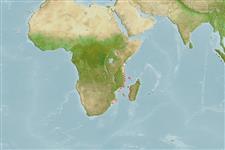Malacostraca |
Decapoda |
Palinuridae
Environment: milieu / climate zone / depth range / distribution range
Ecology
Benthic; depth range 20 - 375 m (Ref. 249). Tropical; 1°N - 32°S, 31°E - 44°E (Ref. 4)
Indo-West Pacific.
Length at first maturity / Size / Weight / Age
Maturity: Lm ? range ? - ? cm Max length : 35.0 cm BL male/unsexed; (Ref. 4)
It has a maximum total body length 35 cm; a carapace length of 14 cm; and an average carapace length of 10 cm (Ref. 4). Minimum depth from Ref. 122080. Occurs at depths from 216 to 375 and lives on rough substrates with sand and mud (Ref. 4).
Life cycle and mating behavior
Maturity | Reproduction | Spawning | Eggs | Fecundity | Larvae
Members of the order Decapoda are mostly gonochoric. Mating behavior: Precopulatory courtship ritual is common (through olfactory and tactile cues); usually indirect sperm transfer.
Holthuis, L.B. 1991. (Ref. 4)
IUCN Red List Status (Ref. 130435)
CITES status (Ref. 108899)
Not Evaluated
Not Evaluated
Threat to humans
Human uses
Fisheries: commercial
| FishSource |
Tools
Internet sources
Estimates based on models
Preferred temperature
(Ref.
115969): 4.5 - 4.5, mean 4.5 (based on 1 cells).
Vulnerability
Low vulnerability (25 of 100).
